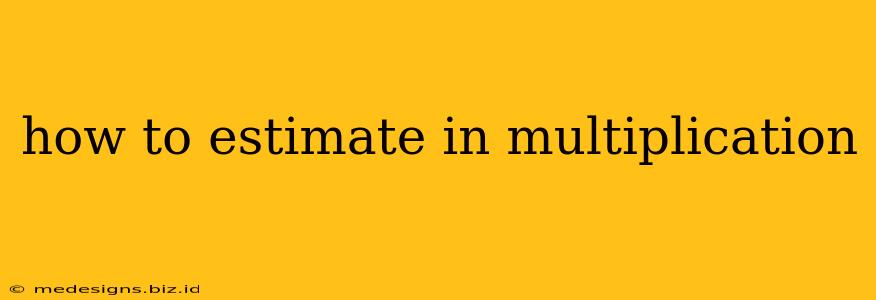Estimating in multiplication is a valuable skill that allows you to quickly check your answers, make informed decisions in real-world situations, and even solve problems mentally without a calculator. This guide breaks down various techniques to help you master the art of estimation in multiplication.
Why Estimate in Multiplication?
Before diving into the methods, let's understand why estimating is so important:
- Speed and Efficiency: Estimation provides a rapid way to get a close approximation, saving you time and effort, especially when dealing with larger numbers.
- Error Detection: A quick estimate can reveal significant errors in your calculations, allowing you to double-check your work before submitting it.
- Real-World Applications: In everyday life, precise calculations aren't always necessary. Estimation helps you make quick judgments about costs, quantities, and distances.
- Building Number Sense: Regular estimation practice strengthens your understanding of numbers and their relationships, improving your overall mathematical intuition.
Effective Estimation Techniques
Here are several strategies for estimating products:
1. Rounding to the Nearest Power of 10
This is the most common and simplest method. Round each number to the nearest power of 10 (10, 100, 1000, etc.) before multiplying.
Example: Estimate 38 x 62.
- Round 38 to 40.
- Round 62 to 60.
- Multiply: 40 x 60 = 2400.
This gives a reasonable estimate; the actual answer is 2356.
2. Rounding to Compatible Numbers
This technique involves rounding numbers to values that are easy to multiply mentally. Look for numbers that "work well" together.
Example: Estimate 27 x 42.
- Round 27 to 30.
- Round 42 to 40 (or even 45, if you prefer to multiply with 30).
- Multiply: 30 x 40 = 1200 (or 30 x 45 = 1350).
Both estimates are acceptable; the actual answer is 1134.
3. Front-End Estimation
This involves focusing on the leading digits of the numbers. It's particularly useful for larger numbers.
Example: Estimate 128 x 537.
- Use only the leading digits: 1 x 5 = 5
- Add the appropriate number of zeros: 50000 (consider the size of the numbers being multiplied)
The actual answer is 68,876; our estimate is somewhat off, but this technique is better suited for quick, rough estimates rather than very accurate results.
4. Using Compatible Factors
Look for factors within the numbers you're multiplying. This method can be highly efficient in specific cases.
Example: Estimate 15 x 48.
*Notice that 15 is close to 12, which is a factor of 48 (48/12 = 4)
The result will be approximately 4 x 15 = 60.
The actual answer is 720. This technique isn't always suitable, but when applicable it can result in very fast estimation.
5. Breaking Down Numbers
Break larger numbers into smaller, more manageable parts before multiplying.
Example: Estimate 25 x 12.
- Think of 25 as 20 + 5.
- 20 x 12 = 240
- 5 x 12 = 60
- 240 + 60 = 300.
The actual answer is 300.
Practice Makes Perfect
Estimating multiplication is a skill that improves with practice. The more you experiment with different techniques, the more comfortable and accurate you will become. Start with simple examples and gradually increase the difficulty. The key is to develop a sense of number magnitude and to find the estimation method that best suits the situation. Don't be afraid to make mistakes; they're an essential part of the learning process.
